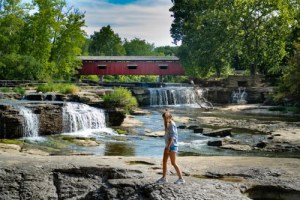 Visiting covered bridges is like time-travel to the past when lives were very different. There was a slower pace of life when covered bridges were being built. Cell phones, televisions, and automobiles didn’t exist. Covered bridges embody a time when life was simpler. As people started moving to bustling cities, covered bridges came to represent peaceful, quaint images of the past. Nostalgia and romance are invoked by visiting a covered bridge.
Visiting covered bridges is like time-travel to the past when lives were very different. There was a slower pace of life when covered bridges were being built. Cell phones, televisions, and automobiles didn’t exist. Covered bridges embody a time when life was simpler. As people started moving to bustling cities, covered bridges came to represent peaceful, quaint images of the past. Nostalgia and romance are invoked by visiting a covered bridge.
Covered bridges are common subjects in film, novels, and art. The novel The Bridges of Madison County is one of the best examples. Covered bridges are also mentioned in Edgar Allan Poe’s poem Never Bet the Devil Your Head, the Joe Hill novel NOS4A2. Covered bridges are also mentioned in films like The Need for Speed, Beetlejuice, and Funny Farm. Covered bridges are also common in fine art photography.
Most covered bridges were located in remote rural settings over creeks or small rivers. The bridges stood in rustic eloquence on country roads over streams and rivers and surrounded by woods, wildflowers and pastoral farms. They are a part of Americana.
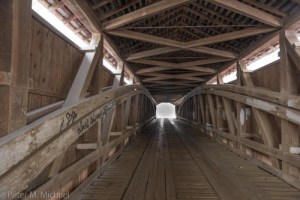 Covered bridges are made of wooden trusses, a deck, siding, and a roof, so the entire bridge is enclosed. If a wooden bridge isn’t covered, it will eventually rot away and need to be replaced. The roof of a covered bridge keeps the moisture off of the bridge, which significantly extends its lifespan. However, as time passes and these old bridges are neglected, they begin to fall into disrepair. Some are washed away, and others are allowed to fall apart.
Covered bridges are made of wooden trusses, a deck, siding, and a roof, so the entire bridge is enclosed. If a wooden bridge isn’t covered, it will eventually rot away and need to be replaced. The roof of a covered bridge keeps the moisture off of the bridge, which significantly extends its lifespan. However, as time passes and these old bridges are neglected, they begin to fall into disrepair. Some are washed away, and others are allowed to fall apart.
The typical style of covered bridges was invented in Switzerland in the mid-1700s. Most of the covered bridges in the United States were built between 1820 and 1910. There were more than 12,000 covered bridges built in the US, but less than a thousand still exist. By the mid-1800s, wrought or cast iron became more readily available, and metal bridges did not need as much protection from the elements as wooden bridges. Most covered bridges were only one lane wide, so travelers needed to wait their turn to cross–the iron bridges allowed for much more traffic.
Some covered bridges have a sign that says, “cross at a walk.” The rhythmic running of a horse can set up destructive vibrations in a bridge. The sign does not require the automobile, wagon, or bicycle rider to dismount and walk across the bridge.
Covered bridges were referred to as “kissing bridges” since they provided one of the few places courting lovers could find some privacy hundreds of years ago. The bridges were built to connect land to land but they became places to connect person to person. Romantic interludes often occurred in the relative privacy they offered. They were a perfect place for sneaking smooches, away from prying eyes and nosy neighborhoods. Many of the bridges are covered with romantic notes left by visitors. Many couples have come for a stroll across these picturesque bridges that continue to be perfect location for an engagement or wedding photoshoot.
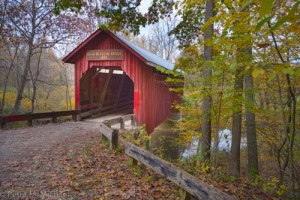 Like other landscape images, the best time to photograph a covered bridge is early morning or late in the day provides the best quality of light. This is when the sun is at a lower angle gives oblique lighting that accentuates textures. Twilight or the “blue hour” can also be a wonderful time to capture feeling and mood. I have sometimes added warm artificial light inside the covered bridge during twilight. Once daylight gives way to twilight, you will need a tripod and shutter release to capture the correct exposure.
Like other landscape images, the best time to photograph a covered bridge is early morning or late in the day provides the best quality of light. This is when the sun is at a lower angle gives oblique lighting that accentuates textures. Twilight or the “blue hour” can also be a wonderful time to capture feeling and mood. I have sometimes added warm artificial light inside the covered bridge during twilight. Once daylight gives way to twilight, you will need a tripod and shutter release to capture the correct exposure.
Covered bridges can be picturesque any season of the year. There may be more visitors during the summer months when people are more likely to be traveling. Autumn can add brilliant foliage to your image. And winter also provides great photo ops for covered bridges. Try to get out early after a winter storm when covered bridges are perfectly coated with freshly fallen snow.
Cloudy days provide the advantage of reducing the range of difference between the interior of the bridge and the sky. High dynamic range (HDR) is another technique to balance the sky and the bridge interior. If you are shooting in RAW format, you can frequently recover some of the interior shadow areas.
A three-quarters angle that shows the entrance, side, roof and river creates an appealing image but trees and brush sometimes obscure this viewpoint. A winding road can provide a leading line that draws one eye into the image. Photographing a peaceful river scene framed by the covered bridge windrow can also provide an interesting image.

Cataract Falls Covered Bridge
The Cataract Falls Covered bridge was built in 1876 by the Smith Bridge company. It is the only remaining one in Owen County. At one time, Cataract Falls was the most photographed covered bridge in the US.
Houck Covered Bridge is not obscured by trees and brush, which makes it easier to photograph. It is a good choice for sunrise and sunset photographs. This bridge, built in 1880 by the Massillon Bridge Company, uses the Howe Truss system. It is 210 feet long, 16 feet wide, and 15 feet tall with a 3-foot overhang on each end. The roof has been replaced with a metal roof. Depending on the light and reflections, this can detract from the nostalgia.
Mansfield Roller Mill and covered bridge. Mansfield is an interesting town. It is almost a ghost town for much of the year but comes alive for festivals. The Mansfield covered bridge can be difficult to photograph because of power lines and other structures. The Mansfield Roller Mill adds some special character. Other buildings in Mansfield can be interesting subjects. The Mansfield Bridge was completed in 1867. Although built for wagons, the Mansfield Bridge still has a 10-ton load limit. Jacob Rohm built the Mansfield grist mill in 1875. This building replaced an older mill that dates back to 1821, built by James Kelsey and Francis Dickson.
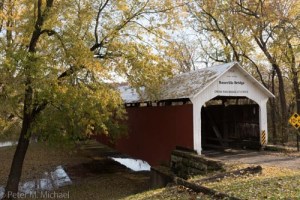 Conley’s Ford Covered Bridge. The bridge was built in 1906. It crosses Big Raccoon Creek. The bridge is a single-span Burr Arch Truss structure. This bridge is built with white pine, while most other covered bridges in the area were predominately built of popular.
Conley’s Ford Covered Bridge. The bridge was built in 1906. It crosses Big Raccoon Creek. The bridge is a single-span Burr Arch Truss structure. This bridge is built with white pine, while most other covered bridges in the area were predominately built of popular.
Bridgeton Covered Bridge. The bridge has been rebuilt, so it’s not original. The current bridge was built to replace two prior open wooden bridges that had fallen in at the same location. The original covered bridge was then built in 1868, just above the mill dam, with the abutments attached to the dam structure. While crossing the first bridge, Owen Wimmer and his family were dropped into the millpond along with their wagon and team when the bridge fell in. J.H. Kerr and others were able to rescue them. A second bridge of similar construction was erected at the same site. This bridge fell in also just after J.H. Kerr had driven cattle across. The Bridgeton mill was established in 1823 and rebuilt in 1870. The mill has been family owned and operated for over 180 years, although not by the same family. The mill grinds wheat into flour and corn into meal with 200-year-old French Buhr stones.
If you are searching for existing photographs of the covered bridges, you can find many examples on In Dancing Light Photography stock images.
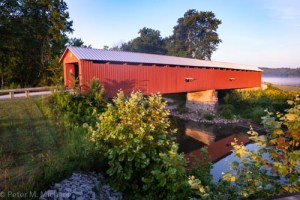
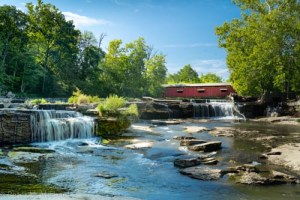

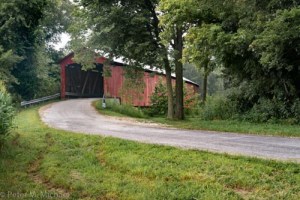
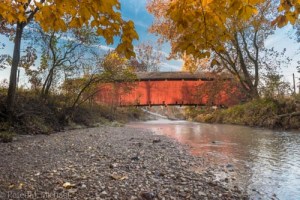
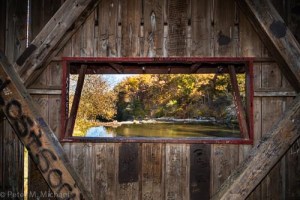
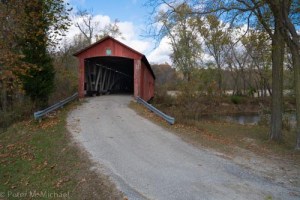
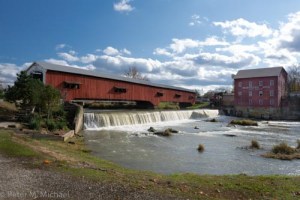





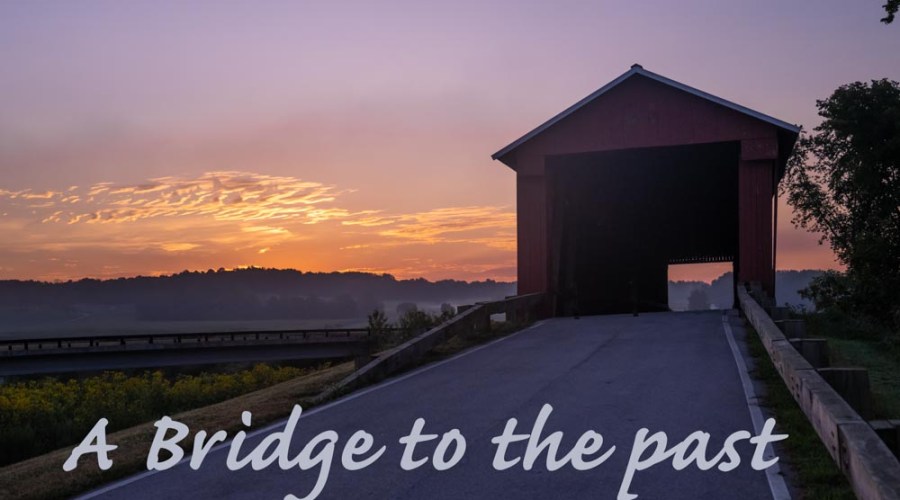
0 Comments